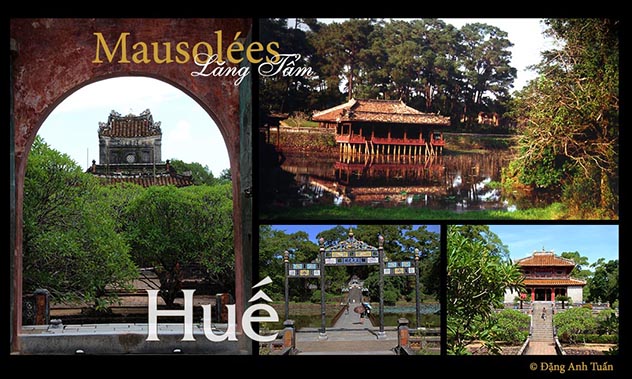En contemplant la vie, je pense avec émerveillement :
Vivre est temporaire, puis retourner à la mort.
La sagesse et la folie partagent les mêmes trois pieds de terre.
La richesse et l’honneur n’ont pas encore atteint leur pleine maturité.
En difficulté devant les yeux, les nuages se dispersent.
Après, la souffrance est aussi imposante que les montagnes.
Je veux interroger les immortels, mais ils ne répondent pas.
Je me force à endurer un peu plus longtemps pour écouter.
The Hue tombs are the most brilliant achievement of ancient Vietnamese architecture. They are also a form of landscape architecture. This art reached its pinnacle in the Hue tombs. « Each royal tomb, with its own unique characteristics, is a magnificent achievement of landscape architecture that also evokes a special resonance in the emotions of visitors. The Gia Long tomb, set within a vast natural garden, evokes a majestic and serene impression. The Minh Mang tomb is full of solemnity, and the Tu Duc tomb brings visitors a peaceful and poetic soul, » these are the remarks of UNESCO Director-General Amadou-Mahtar M’Bow, written after his visit to Hue in 1981.
According to the spiritual beliefs of the Vietnamese people, death is not the end. Therefore, the Hue tombs often have two main parts: a tomb section and a palace section. The tomb section is the area where the king’s body is buried. The palace section usually contains many temples, shrines, pavilions, and so on. Sometimes, the palace section was also the residence of the reigning king. For example, the palace area of King Tu Duc has more than a dozen architectural works, large and small, serving the king’s daily life and entertainment: Hoa Khiem Palace where the king worked, Luong Khiem Palace where the king ate and slept, Xung Khiem Pavilion and Du Khiem Pavilion where the king relaxed, wrote poetry, enjoyed the scenery, and fished. Additionally, there is Minh Khiem Duong, a theater, Y Khiem Institute, and Tri Khiem Institute, which were the quarters for the concubines serving the king.
This artistic architectural style of tombs originates from the ancient human concept of « living is temporary, death is returning » (Life is temporary, death is the return). This is a concept derived from Buddhism, reminding that life in this world is only temporary, and death is the return to the eternal realm, so death is normal and nothing to be afraid of. King Tu Duc also once mentioned this concept in his poem « Contemplating Life »:
Contemplating life, I think with awe
Living is temporary, then returning to death
Wisdom and folly share the same three feet of earth
Wealth and honor have not yet fully matured
Struggling before eyes, clouds scatter apart
Afterwards, suffering is also imposing as mountain
Wanting to ask the immortals, but they do not answer
Forcing myself to endure a little longer to listen.
Therefore, while alive, every king thought about building a tomb, a place where the king would return to eternal life. The tomb and the mausoleum are not far apart; sometimes they are just within arm’s reach. Living leisurely and enjoying oneself in the tomb area, and when dead, not worrying about returning to the mausoleum area. According to the natural law of life, the tomb and mausoleum become a realm of the dead because they allow sorrow to give way to joy. They help people become accustomed to the realm of death and especially prepare them to be ready for the angel of death to take them to the other world, a place of eternal rest.
A Western traveler, Charles Patris, once said that the tombs of Hue are like a « smiling » place of mourning, and also a place where one finds « trembling joy » in one of his poems. Each tomb in Hue is not only a cultural historical relic but also a unique scenic spot with its own private characteristics.
- Plan des Mausolées impériaux de Huế
- Mausolée de Gia Long
- Mausolée de Minh Mạng
- Mausolée de Thiệu Trị
- Mausolée de Tự Đức
- Mausolées de Dục Đức, Thảnh Thái et Duy Tân
- Mausolée de Khải Định
- Biographie sur l’empereur Tự Đức
Ouvrages recommandés
- Patrimoine mondial au Vietnam. Edition Thế Giới.
- Những di sản thế Giới ở Việtnam. Nhà Xuất Bản Đà Nẳng.
- (Patrimoine Mondial du Vietnam. Editeur Đà Nẵng).
- Kiến trúc cố đô Huế: Phan Thuận An. Nhà xuất bản Thuận Hóa 2001.


